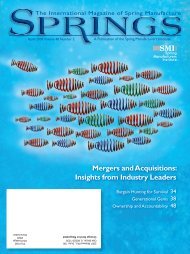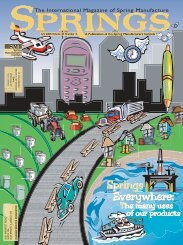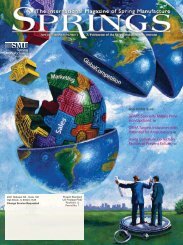Solid Height - Spring Manufacturers Institute
Solid Height - Spring Manufacturers Institute
Solid Height - Spring Manufacturers Institute
Create successful ePaper yourself
Turn your PDF publications into a flip-book with our unique Google optimized e-Paper software.
tions (CMA) and the Manufacturing <strong>Institute</strong> of<br />
the National Association of <strong>Manufacturers</strong> (NAM).<br />
Economist Joel Popkin, the report’s author, stated,<br />
“Though the U.S. accounts for 40 percent of all R&D<br />
spending in the industrial world, we cannot become<br />
complacent about this leadership position. The rapid<br />
growth in overseas manufacturing is creating new<br />
global centers with the critical mass necessary to<br />
build their own innovation machines.”<br />
According to the report, five factors indicate that<br />
America’s innovation process is at risk:<br />
1. Manufacturing output since the last recession<br />
lags that of earlier economic recoveries – its 15%<br />
growth is only half the pace averaged in recoveries<br />
of the past half-century.<br />
2. Manufacturing capacity remains underutilized,<br />
slowing investment in new plants and equipment.<br />
Since the last recession, total plant and equipment<br />
investment has risen at half the pace averaged in<br />
recoveries of the past half-century. Manufacturing<br />
capacity has grown at less than one percent annually<br />
(compared with five percent in the 1990s).<br />
3. The U.S. share of global trade in manufactured<br />
products has shrunk, falling from 13 percent in the<br />
1990s to 10 percent in 2004. The U.S. now runs a<br />
trade deficit in advanced technology products, and<br />
the U.S. share of global trade in some of the highest<br />
value-added export industries, such as machinery<br />
and equipment, is falling.<br />
4. U.S. manufacturing offers rewarding and<br />
desirable careers for highly skilled workers. Yet<br />
the perception that manufacturing employment is<br />
unstable and lacks job opportunities discourages<br />
new worker entry. While manufacturing continues to<br />
pay better than other industries, the sector is experiencing<br />
a broadening shortage of skilled workers.<br />
5. America’s long-standing leadership in R&D is<br />
being challenged. While the U.S. continues to spend<br />
more than any other country on R&D investment,<br />
U.S. growth in R&D has averaged only about one<br />
percent per year, in real terms, since 2000.<br />
“If the innovation process goes offshore, America<br />
will lose much of its capacity to generate wealth and<br />
a decline in long-term economic growth is assured,”<br />
concludes Popkin.<br />
Mahr Federal Inc., Providence, RI, has<br />
announced that its ISO/IEC 17025 accreditation<br />
by the National Voluntary Laboratory Accreditation<br />
Program (NVLAP) has been expanded to include<br />
the company’s Field Service Group. Qualified Field<br />
Service Group personnel will now be able to provide<br />
accredited calibration services at customer<br />
facilities. Customers can have large measurement<br />
systems calibrated onsite with the added benefit of<br />
accreditation.<br />
Chromium Corrections/Clarifications<br />
In the April 2006 issue of <strong>Spring</strong>s, the article<br />
“2006: the Year of RoHS” discussed the European<br />
directive restricting hazardous substances, including<br />
hexavalent chromium. The word “hexavalent”<br />
was omitted from the sentence, “Pretty soon products<br />
with cadmium, lead, hexavalent chromium<br />
and other contaminants will be restricted in more<br />
countries than not.”<br />
It is important to note that chromium is an<br />
essential element of stainless steel. The chromium<br />
contained in stainless steel is not the same as the<br />
hexavalent chromium cited in the RoHS directive.<br />
Also in the April issue, the definition of stainless<br />
steel on page 22 in the “Glossary of Wire Terms,”<br />
says that 18/8 stainless steel contains 18 percent<br />
nickel. However, the definition should read: “Stainless<br />
Steel – A high-chromium steel, often including<br />
nickel, which is resistant to corrosive and oxidizing<br />
attack. The most well known type is 18/8, an<br />
austenitic steel containing about 18% chromium<br />
and 8% nickel.”<br />
A recent research report by the AberdeenGroup,<br />
“The Product Quality Benchmark: Achieving Quality<br />
across the Global Manufacturing Network”<br />
indicates that pressure from customers, regulatory<br />
SPRINGS July 2006 33





